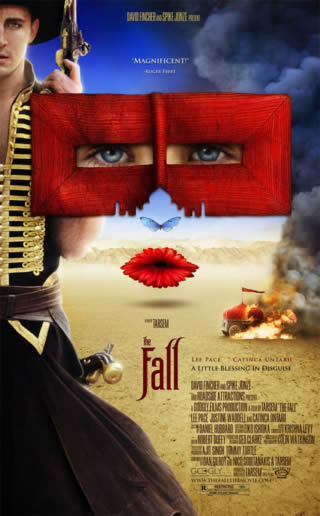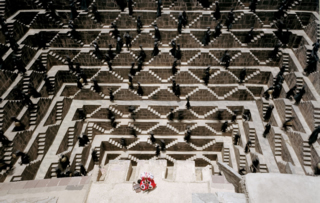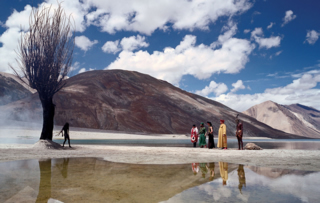Movies

New Releases • A-D • E-H • I-P • Q-Z • Articles • Festivals • Interviews • Dark Knight • Indiana Jones • John Wick • MCU
The Fall
Directed by Tarsem
Rated R
The Fall is a gorgeous piece of moviemaking but it's almost heartbreaking that it's not something more.
Alexandria the Great

A fanciful tale set "once upon a time" in 1915 Los Angeles, back in the golden silent movie era, The Fall centers around a stunt man and a little girl he befriends in a hospital. They've both fallen, literally and figuratively, and they're both in need of love and care.
Alexandria (9-year-old Catinca Untaru in a remarkable, Spielberg-caliber freshman performance) broke her arm after falling from a tree while picking oranges. Roy (Lee Pace, Miss Pettigrew Lives for a Day) suffered an injury while performing a stunt involving a horse, a train, and a bridge.
Roy's bigger pain, though, comes from his broken heart. He's so disconsolate over his loss in love that he's contemplating suicide.
Homing in on the mischievous, curious little girl, Roy begins to tell her a story of a masked bandit and his four partners. Each one has a bone to pick with the e-vil (yes, e-vil) Governor Odious. It's a shameless collection of clichés that plays off all the standard conventions of fables and storytelling. Together, Roy and Alexandria play out the tale in their minds' eyes, with the key roles being played by themselves and others in and around the hospital.
Roy uses his "epic" story to reel in Alexandria and befriend her. But, alas, his ulterior motives come to light as he refuses to finish the story until Alexandria runs a couple errands for him.
The B-Team


The Fall is loaded with eye-popping visuals.
Photos: Googly Films, LLC
The Fall, in short, looks and feels a heckuva lot like Terry Gilliam's The Adventures of Baron Munchausen. In so many respects, it seems like a great Gilliam movie that Gilliam had absolutely nothing to do with.
Instead, the director is Tarsem Singh Dhandwar (he goes by the professional name of, simply, "Tarsem"), and he has only one other feature under his belt, the Jennifer Lopez curiosity piece from 2000 called The Cell. Aside from that dabbling, Tarsem's mainstay is in music videos and commercials.
What Tarsem's done here, though, is unprecedented. The movie was self-financed in order to best satisfy his own obsessions with the material and he filmed it all over the world. The tricky, nifty thing is that he shot the movie as a side project to his various "day-job" projects that were the impetus for traveling all over the planet.
Some locations are incredibly brief flashes of whirlwind storytelling, such as the Pyramids of Giza, the Great Wall of China, and the Eiffel Tower. Other locations include Cambodia, India, Spain, and Brazil. Name a country and the chances are reasonably good Tarsem might have some footage in The Fall.
As a by-product of the self-financing and self-obsession, The Fall has sat around for two years before finally finding a distributor. It's most certainly a movie that deserves an audience, but another tricky thing about The Fall is that, amid all the luscious scenery, gorgeous costumes, eye-popping sets, and verbal playfulness, it ultimately falls a bit flat.
Googly, Googly, Googly
That playfulness openly, unabashedly winks at the audience in the same manner as Munchausen and other similar flicks like The Princess Bride (but make no mistake about it, this is a strange mutt of a movie that's R-rated and it's not for the wee ones). In one particular case of silly fairy tale storytelling, the Masked Bullet fires a pistol and the bullet hits a locket dangling from a fair maiden's neck. The bullet was the only thing that ever opened the locket and the inscription is read aloud. It's a long, long inscription, to the point where the Masked Bandit stops and asks if all that text is really engraved on the locket.
It's good stuff for those with a sense of humor that lends itself to enjoying Shrek's animated fractured fairy tales or, more broadly, an appreciation of fantastic filmmaking style and cinematography.
But the whole crux of the movie relies on Roy's broken heart and, while a lovelorn broken heart is always good for some degree of emotional manipulation, so little is made of Roy's real-world romance, it's not entirely clear how real it really is – or was. The object of his desire is a nurse in the hospital, which doesn't quite seem to jibe with the opportunity for any meaningful relationship besides some Florence Nightingale situation on her part and wishful thinking on his part.
After two hours of seeing Roy all melancholy and plotting his suicide, even amidst all the sugar-shock-inducing eye candy, there's a nagging desire to smack him upside the head and tell him to "get a life and get over it!"
• Originally published at MovieHabit.com.


